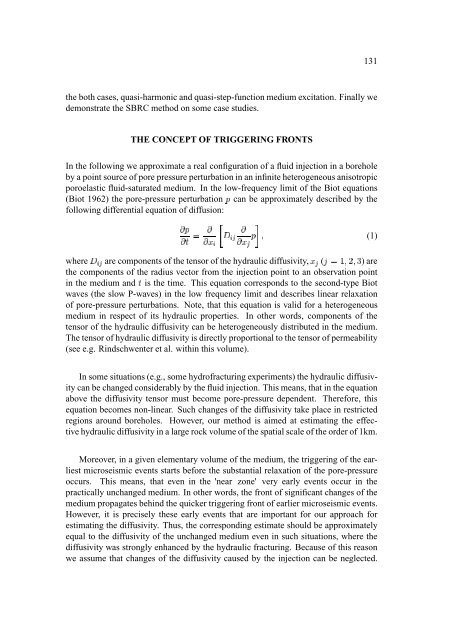Annual Report 2000 - WIT
Annual Report 2000 - WIT
Annual Report 2000 - WIT
Create successful ePaper yourself
Turn your PDF publications into a flip-book with our unique Google optimized e-Paper software.
ˆ<br />
‘<br />
Ö<br />
Ö<br />
Ö<br />
Ö<br />
131<br />
the both cases, quasi-harmonic and quasi-step-function medium excitation. Finally we<br />
demonstrate the SBRC method on some case studies.<br />
THE CONCEPT OF TRIGGERING FRONTS<br />
In the following we approximate a real configuration of a fluid injection in a borehole<br />
by a point source of pore pressure perturbation in an infinite heterogeneous anisotropic<br />
poroelastic fluid-saturated medium. In the low-frequency limit of the Biot equations<br />
(Biot 1962) the pore-pressure perturbation can be approximately described by the<br />
following differential equation of diffusion:<br />
Ö<br />
Ö<br />
ÄÜ´• (1)<br />
»P×]Ú<br />
where »P×]Ú are components of the tensor of the hydraulic diffusivity, ÊÛÚ (ݽ‘¿Ì•?“Û•ÆÞ ) are<br />
the components of the radius vector from the injection point to an observation point<br />
in the medium and ˆ is the time. This equation corresponds to the second-type Biot<br />
waves (the slow P-waves) in the low frequency limit and describes linear relaxation<br />
of pore-pressure perturbations. Note, that this equation is valid for a heterogeneous<br />
medium in respect of its hydraulic properties. In other words, components of the<br />
tensor of the hydraulic diffusivity can be heterogeneously distributed in the medium.<br />
The tensor of hydraulic diffusivity is directly proportional to the tensor of permeability<br />
(see e.g. Rindschwenter et al. within this volume).<br />
Ê1×ÙØ<br />
ÊÛÚ<br />
In some situations (e.g., some hydrofracturing experiments) the hydraulic diffusivity<br />
can be changed considerably by the fluid injection. This means, that in the equation<br />
above the diffusivity tensor must become pore-pressure dependent. Therefore, this<br />
equation becomes non-linear. Such changes of the diffusivity take place in restricted<br />
regions around boreholes. However, our method is aimed at estimating the effective<br />
hydraulic diffusivity in a large rock volume of the spatial scale of the order of 1km.<br />
Moreover, in a given elementary volume of the medium, the triggering of the earliest<br />
microseismic events starts before the substantial relaxation of the pore-pressure<br />
occurs. This means, that even in the 'near zone' very early events occur in the<br />
practically unchanged medium. In other words, the front of significant changes of the<br />
medium propagates behind the quicker triggering front of earlier microseismic events.<br />
However, it is precisely these early events that are important for our approach for<br />
estimating the diffusivity. Thus, the corresponding estimate should be approximately<br />
equal to the diffusivity of the unchanged medium even in such situations, where the<br />
diffusivity was strongly enhanced by the hydraulic fracturing. Because of this reason<br />
we assume that changes of the diffusivity caused by the injection can be neglected.







